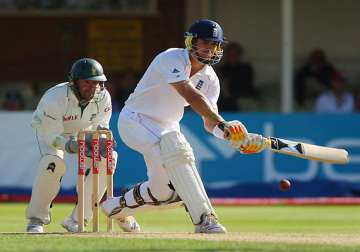Colombo, April 5: England's batsman Kevin Pietersen was given an official warning for trying to play the switch hit before Tillakaratne Dilshan was in his delivery stride on the third afternoon at the P Sara Oval.
Pietersen, who made his 20th Test hundred, began to get into place for the shot as Dilshan started his run-up and the bowler twice aborted his run up.
The incident occurred during an enthralling head-to-head between Pietersen and Dilshan which had already seen Pietersen switch his grip around to strike the bowler through the off side.
However, Pietersen then began to set himself earlier for the shot and Dilshan refused to deliver which led to a stalemate.
Asad Rauf, the umpire at the bowler's end, signalled the warning to Pietersen after the second aborted delivery and also informed his colleague Bruce Oxenford.
Pietersen gesticulated towards the officials, clearly unsure about what he was being penalised for.
The immediate consequence was that if Pietersen, or any other England batsman, did it again during the innings Sri Lanka would be awarded five penalty runs.
Andy Flower, the England team director, immediately went to the match referee's room for clarification over the issue, his second visit of the match following his questioning of a review against Thilan Samaraweera on the first day.
The ball after the official warning, Pietersen reverse-swept again and brought up his hundred. He went on to make 151 from 165 balls as England pushed for their first victory of the winter.
The ICC statement in May last year says: "The ICC Cricket Committee adopted the updated directive introduced earlier in the year which prevents the batsman from altering his grip or stance before the bowler enters his delivery stride. Should the bowler see a batsman change his grip or stance prior to the delivery stride the bowler can decide not to bowl the ball."
After Pietersen first unveiled the switch hit against New Zealand in 2008 it provoked debate about the legality of the shot because, for example, if a bowler wants to change from right to left arm (however rare that occurrence may be) he has to inform the umpire and the batsman. There are also the implications for wide deliveries and lbw.
However, the MCC approved the shot, citing the difficultly level as a main reason, and hailed it as a good innovation for cricket.
"MCC believes that the 'switch-hit' stroke is exciting for the game of cricket," was the conclusion.
"Indeed, the stroke conforms to the Laws of Cricket and will not be legislated against...MCC believes that the 'switch-hit' stroke is a difficult shot to execute and that it incurs a great deal of risk for the batsman. It also offers bowlers a good chance of taking a wicket and therefore MCC believes that the shot is fair to both batsman and bowler."
